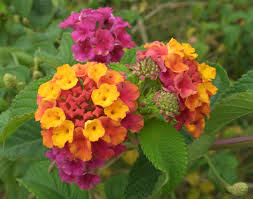
by Sheila Dunning | Feb 20, 2015
It’s Growing So Well It Must Be A Good Plant. Right?

Lantana camera
You know that plant in the corner of the yard that seems to be taking over? It’s the one that your friend “passed along” because they had plenty of them and wanted to share. After all, it grows so well. How can you go wrong? The odds are that vigorous plant is a non-native species. The majority of what is sold in nurseries are introduced from a foreign country and developed for their uniqueness.
The problem is that many of the plants brought into the United States arrive without their natural enemies. Under the long, warm growing season found in Florida, these non-native plants become the dominant plant in an area and manage to out-compete the native plants. When this happens, these introduced plants get labeled as an “invasive species”.
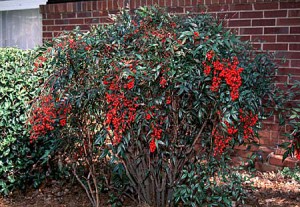
Nandina domestica
If you want to learn more about your friend’s ”passalong” plant be sure to visit the Assessment of Nonnative Plants in Florida’s Natural Areas website and database at http://assessment.ifas.ufl.edu/.

Ruellia brittoniana Mexican Petunia
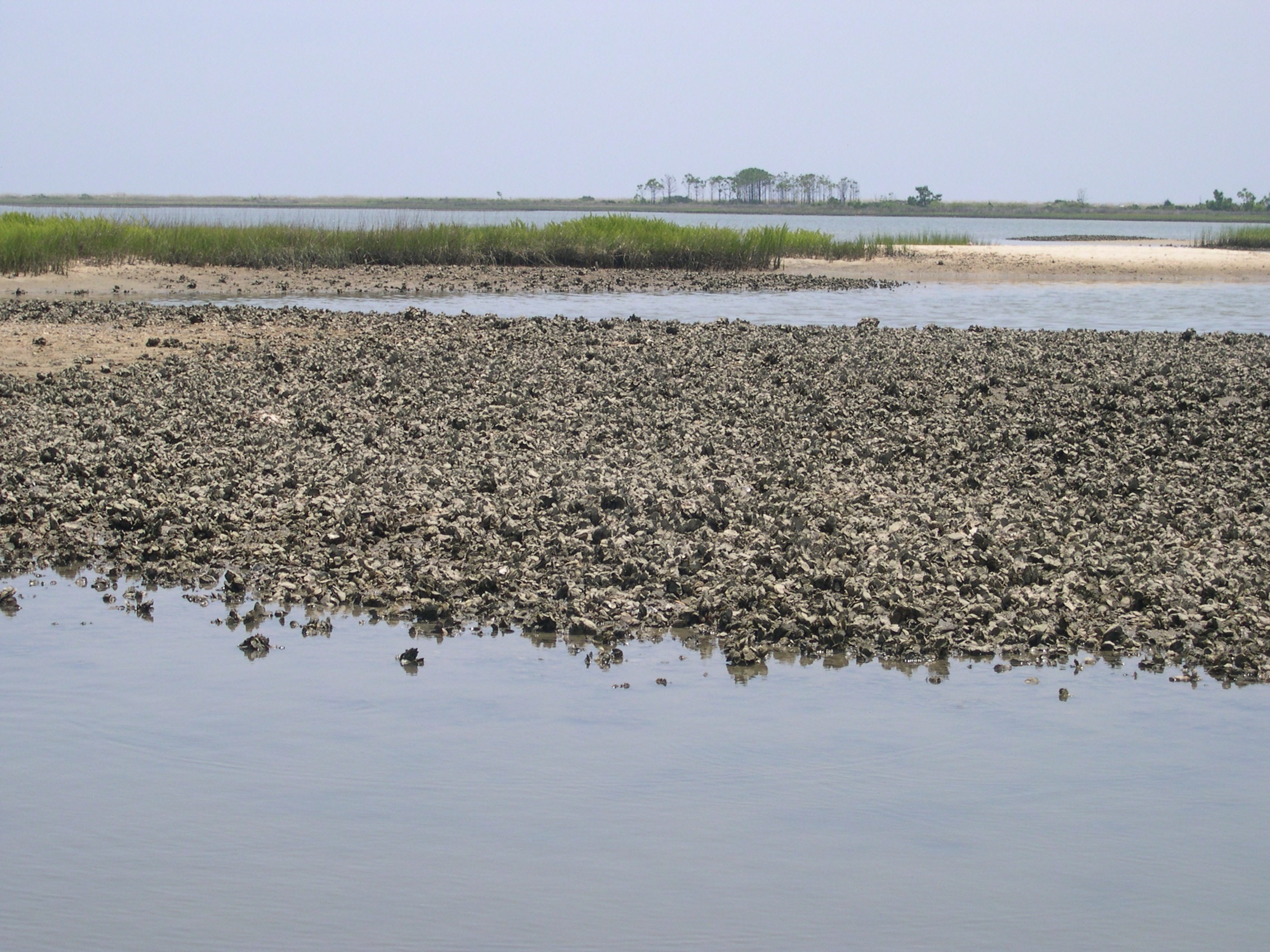
by Erik Lovestrand | Feb 6, 2015
Nature has provided us with an incredible resource in the diverse assemblage of molluscan shellfish that inhabit our coastal bays and estuaries. One bivalve species in particular provides many human benefits. The eastern oyster (Crassostrea virginica) has not only proven to be a preferred food species for people but also derives many vital ecosystem services through its existence in our near-shore estuaries. Oysters are born as planktonic larvae that drift in the water for about 2 weeks. They are called a spat when they settle out of the water column and glue themselves to a suitable hard surface, such as another oyster shell, and begin to grow their own shell. Oysters feed on particulates in the water throughout their life and when mature can filter as much as 50 gallons per day. Because of this life style they provide some degree of water purification and improvement in water clarity. The structure of an oyster reef is also a valuable habitat component which provides shelter for a plethora of small creatures that support a vast food web in the estuary ecosystem.
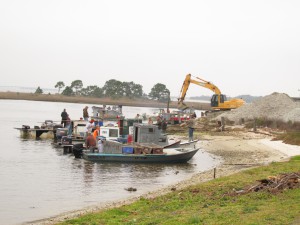
Oystermen participate in shelling program for Apalachicola Bay
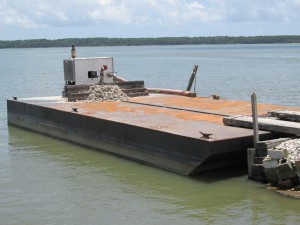
Barges will also be used to relay shells for replenishing oyster habitat.
Although we have several native species of oysters in the Gulf of Mexico the eastern oyster is the only species that supports a commercial industry. in Florida, the bulk of that industry has traditionally been centered around Apalachicola Bay in the mid-Panhandle region of the state. This one estuary system typically produces 90 percent of the state’s oyster crop and 10-13 percent of the nation’s harvest. Some good harvest years have yielded 4-6 million pounds of oyster meat (shells excluded) from this single bay. In recent years however there has been a dramatic decline in oyster abundance. The industry, along with concerned natural resource managers, is seeking to rebuild numbers to a sustainable harvest level. The reasons for this precipitous drop in numbers is the subject of much debate but savvy natural resource professionals believe a combination of factors have been involved over several years to cause the current situation.
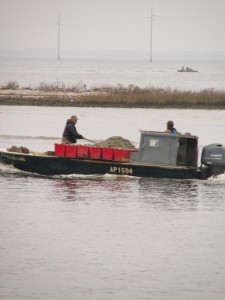
Fossil oyster shell being relayed to bay bottom.
So, how do you bring back a thriving oyster industry from the brink of collapse? Several factors need to be considered and addressed as part of a holistic management approach. At the present time there are two primary mechanisms being employed to support increased oyster recruitment to Apalachicola Bay. The first involves “planting” a suitable material on the bay bottom for oyster spat attachment and growth. In the past this has primarily consisted of oyster shells from the shucking plants. More recently the industry has been employing the use of fossil shell material from a local mine. Oystermen are being employed to transfer the shell from land-based loading areas to the designated deposition sites in the bay. Funding is also forthcoming to allow shelling by barges to cover more area. The other strategy to assist with recovery has involved the use of regulatory authority in consultation with local experts and oystermen with decades of experience on the bay. This approach can reduce the harvest pressure on oysters and support a more rapid recovery, given proper conditions in the estuary. Bag limits have been reduced, enforcement has been stepped up to ensure compliance with the rules, and harvest areas have been adjusted.
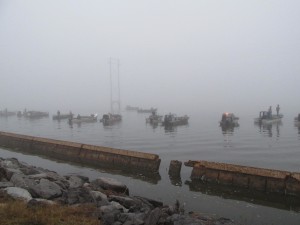
Oystermen line up early to receive shell for relay project.
There are, of course, other important aspects to the solution for bringing back the thriving industry of the past and many of them relate to natural cycles of drought and flooding. Increasing human demands for water from the river system that feeds the bay tend to magnify the effects of natural drought cycles. If salinity remains high for longer periods there is an increased pressure from oyster predators that typically are limited by lower salinity. Factors related to oyster diseases and parasites are also in the mix. To say that it is a complicated situation would be an understatement. Researchers who have studied the system for their entire careers find it difficult to quantify the problems and solutions for this large, complex natural ecosystem that has been an important cultural and economic component of Florida’s makeup since early humans roasted or cracked open the first oyster. Hopefully, with enough concerned partners working towards effective management strategies we can once again enjoy in abundance the wholesome, delicate morsels that have been called the food of the gods.
Article by: Erik Lovestrand
Franklin County Extension Director
Sea Grant Regional Agent II
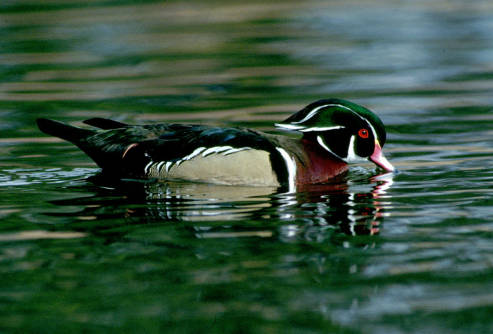
by Rick O'Connor | Jan 30, 2015
Wood ducks are one of the most colorful ducks in North America. Breeding males showcase an unbelievable combination of colors including a red bill and eyes, a metallic purplish-green crested head, black cheeks with thick white stripes, a maroon chest and rump, black and blue wings, dark yellow sides, and a white belly. The drab grayish-brown females are most easily recognized by their white eye ring and crested head.
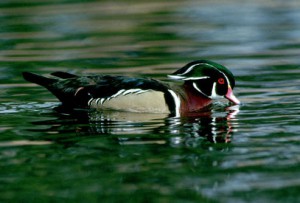
A brightly colored male wood duck. Photo: USFWS National Digital Library
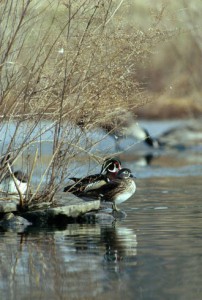
A pair of wood ducks with the more drably colored female in the foreground. Photo: USFWS National Digital Library
Another distinguishing characteristic of wood ducks is their habit of nesting in Florida. Few species of ducks do this.
In Florida, wood ducks begin laying eggs in cavities during late January. They prefer cavities located within a half mile of permanent water bodies. They like cavities in large trees that have clear access to a large entry hole, and shrubs nearby to offer protection for newly-hatched ducklings.
In areas with few large cavity trees, nest boxes can provide alternative locations to nest. Nest boxes intended for wood ducks should be made of natural wood: cedar is a good option because it weathers well. Boxes should be mounted with the entrance hole 6 or more feet above the ground or the surface of the water (if placed over a pond or swamp). Nesting hens will appreciate you placing some cedar wood shavings in the bottom of the box to serve as nesting material. Adding a predator guard below the nest box will greatly increase the chances the hen and her eggs/ducklings don’t get eaten by snakes or raccoons.
It’s best to have nest boxes in place before egg laying begins, which is right about now: late January. However, it’s never too late in the year to put up a new nest box. A box put out later in the year may be useful for a late-nesting hen. Many females have more than one brood during the long nesting long season which won’t end until late summer, so opportunities exist for a nest box installed later in the year to get used.
Wood ducks were given their name because they spend much of their time in wooded swamps, ponds, creeks, rivers, and freshwater wetlands. They prefer bodies of water that have 25-50% open water with 50-75% vegetative cover (a mix of shrubs, emergent plants, and trees) where they can hide and feed.
Wood ducks are sometimes called the “acorn duck” because of their fondness for these treats that fall from oak trees. They have a special preference for acorns from water oaks, laurel oaks, and shumard oaks. They also enjoy duck weed, smartweed, waterlily, seeds from many sedges, rushes, and grasses, as well as fruits from native trees and shrubs and occasionally invertebrates (spiders, insects, snails, crawfish).
Several adaptations differentiate wood ducks from other waterfowl and equip them for life in both woods and water. Well-developed toes and claws allow them to grab onto tree branches while perching. The placement of their legs near the center of their bodies allows them to walk on land more gracefully than most other ducks. Their broad wings and long wide tail increase maneuverability while flying to their cavity nest.
To learn more about wood ducks and what you can do to provide habitat for them, see this publication from UF/IFAS Extension.
Author: Holly Ober – holly.ober@ufl.edu
I am an Associate Professor and Extension Specialist in the Department of Wildlife Ecology and Conservation. My research covers wildlife ecology, habitat management, and identifying creative ways to cope with nuisance wildlife.
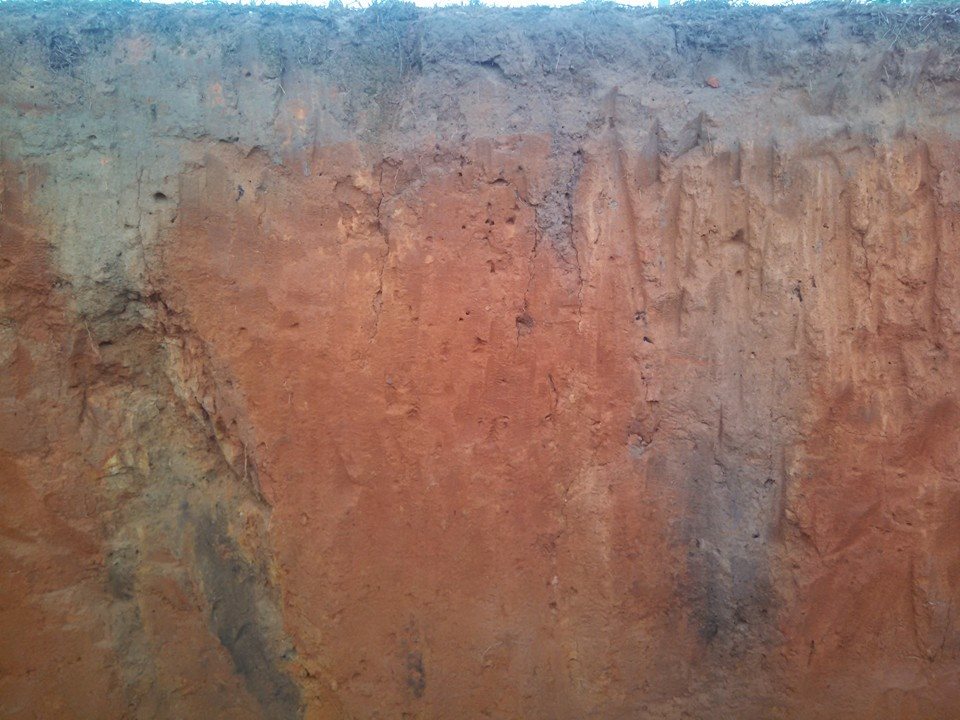
by Jennifer Bearden | Jan 16, 2015

Soil Profile in Gadsden County. Photo by Jennifer Bearden
Many of us walk around daily and give no thought to what is under our feet. We do not consider soil a vital natural resource, but it is. And as with water and air, soil quality is very important to our society. Soils perform 6 functions in our ecosystems.
First it is a medium for plant growth. Plants root into the soil structure and stabilize the plant above ground. It holds nutrients, air, and water which the plants need.
Next, our soils regulate water supplies. Soil quality affects water quality. Contaminants and excess nutrients in poor soils can leach into groundwater. On the other hand, soils can purify poor quality water before it recharges groundwater supplies such as in septic tanks or rain gardens.
Soils also recycle nutrients needed for plant growth. If soils did not perform this function, plants and animals would exhaust the nutrients and there would be an increase in waste in our ecosystems.
Soils provide habitat for numerous organisms. An amazing amount of soil organisms exist hidden from our view. Earthworms, microscopic worms, bacteria, fungi and more call our soils home. These organisms play an important role in keeping our soils productive and our fields yielding crops.
Soils are also used as an engineering medium. For many years, humans have used soils to build and construct homes, roads, pottery and more. Just think of the roads and buildings that would not be here if we did not have soils.
Lastly, soils actually modify the chemical composition of the atmosphere. Air is a major component of our soils and it exchanges gases that are necessary for plant growth and microorganism survival. Also, dry, small soil particles can be picked up by winds causing human health concerns due to dust in the air we breathe.
So, is dirt just dirt or is it much more? I contend that without it, we would not be here today. So when you walk around today, consider the soil under your feet. It will not take long and you will see that soil surrounds us every day and is a very important natural resource.
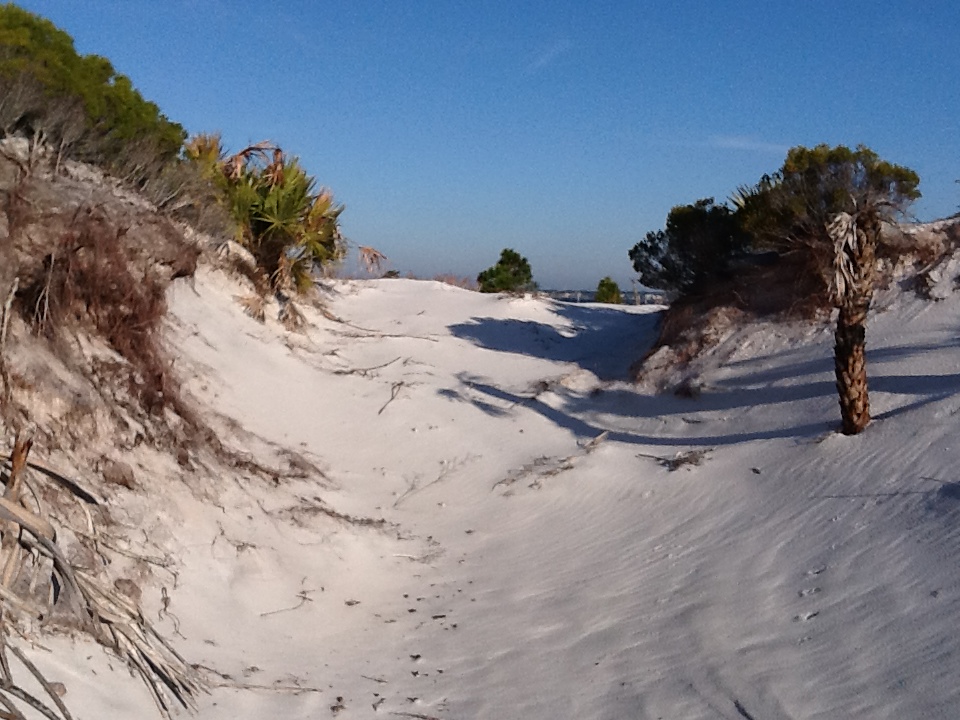
by Rick O'Connor | Jan 16, 2015
Beginning this month we will be posting a series of natural resource articles high lighting Florida’s Panhandle. The photographs and hikes presented in this series are from Escambia and Santa Rosa counties but the same natural places can be found anywhere between the Perdido and Apalachicola Rivers. We hope our readers will visit these places and DISCOVER FLORIDA’S PANHANDLE on their own. This year we will begin at the Gulf of Mexico and visit our BARRIER ISLANDS. We will visit the same location on Santa Rosa Island in Escambia County each month over the course of a year. During this series we should see how things change each season and learn more about our natural places.
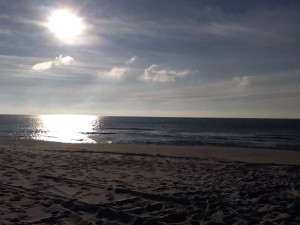
The Gulf of Mexico at sunrise. Photo: Rick O’Connor
Here is the Gulf of Mexico. The northern Gulf is primary sand but their are areas of hard bottom that provide habitat for many of our commercial important fisheries. 450 feet off the shore from this photo is an artificial reef placed by Escambia County for residents and visitors alike to explore. These reefs attract a variety of reef fish and sea turtles and are great for wildlife viewing. Notice how low the sun is in the sky on this winter morning. The shortest day of the year was December 21 (when the sun was it’s lowest) and will be “climbing” as this series continues. Many beach residents use this as their clock!
Our barrier islands are considered the “world’s whitest beaches” and this is because of the high amount of quartz deposited here. In this photograph you can see the water is farther from shore than usual. This is due to the strong north winds blowing water offshore; this happens every winter – but provides feeding opportunities for shorebirds. The sand fencing is used by many of our counties to “kick start” dune restoration.
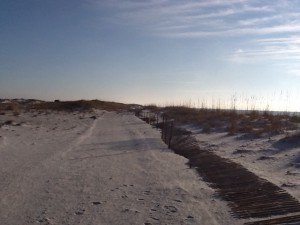
Primary dune line with sand fencing. Photo: Rick O’Connor
Beyond the primary dune on this portion of the island you will find low areas known as swales. These “depressions” will fill with water during rain events and provide much needed freshwater for the organisms who live out here. Barrier islands are xeric environments (meaning “desert like”) and freshwater habitats are very important for many creatures. Some of these ponds are ephemeral (meaning non-permanent) and dry up during some periods of the year.

Swale with dead cattails. Photo: Rick O’Connor
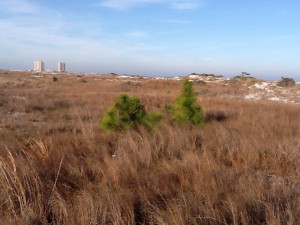
Small pines on the edge of a swale. Photo: Rick O’Connor

The water in most swales is freshwater. Photo: Rick O’Connor
Where the primary dune and swales end the secondary dune fields begin. Because of the primary dunes there is less wind and salt spray which allows different species to take root. The secondary dunes are often identified by their small round shrubs – such as goldenrod and beach heather. These larger plants will trap larger amounts of sand producing larger dunes. On the secondary dunes I usually find lots of tracks. Identifying tracks is difficult (especially in soft sand) but fun. Most of what I saw this winter day were mammals. Raccoons, opossums, and armadillos are very common. Skunks were once common but have been scarce since the hurricane years. Below are tracks of a canine. Many people bring their dogs to the beach but coyote and fox are also found here. These tracks measured about 3.5″ and more round than triangle shaped; suggesting this is a dog.
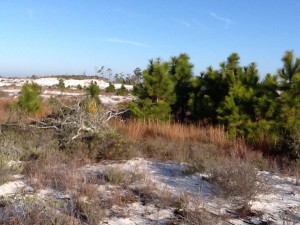
Small secondary dune with small pine trees.

This secondary dune supports a saw palmetto. Many forms of wildlife depending on these shrub areas.
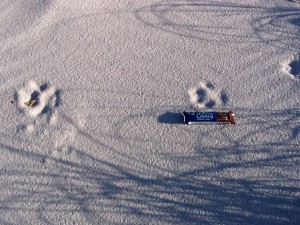
These unidentified canine tracks are probably of a dog; though coyotes are on our islands
Beyond the secondary dunes are the largest dunes on the island, some measuring over 50′, these are the tertiary dunes. With the secondary dunes blocking wind and salt spray larger plants still are allowed to grow. Here we find actually trees; pine, live oak, magnolia to name a few. With the loss of primary and secondary dunes the tertiary dunes are exposed to the wind and salt spray of the Gulf side, which puts them at risk. This is why sea oats and primary dunes are protected in most counties.
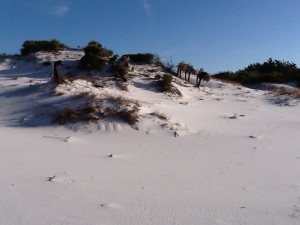
The face of a tertiary dune. Photo: Rick O’Connor
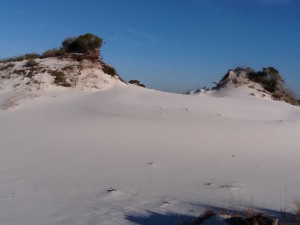
Tertiary dunes are the largest dunes on the island; some reaching over 50′.

Tertiary dunes support trees such as this magnolia and yaupon holly.
The large field of tertiary dunes blocks enough wind that forests and salt marshes can establish themselves on the back side of the island. Here the diversity and abundance of wildlife increases. We have found not only the mammals already mentioned but snakes, freshwater turtles and terrapins, and a variety of birds. This winter day I found several small woodland and mocking birds. Some of our islands have deer and alligators.

From atop a tertiary dune you can view the maritime forest, salt marsh, and sound beyond. Photo: Rick O’Connor
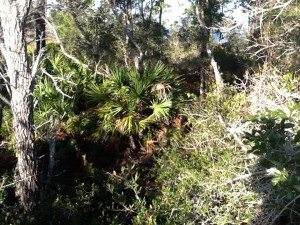
Within the maritime forest you will find a variety of plants and animals.
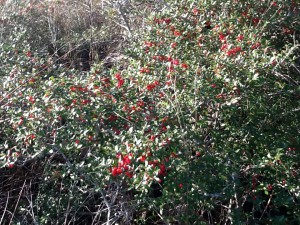
Holly’s are famous for having the bright red berries around Christmas time. Here in January the berries are still found on some of them.
Between the maritime forest and the salt marsh you may find freshwater ponds. Like the swale ponds, these places are great places to find wildlife. Though I have not seen them in many years I have found alligators in this area. These ponds support populations of amphibians and small fishes.
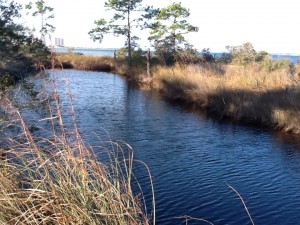
This freshwater pond has bull minnows, amphibians, snakes, and – in the past – alligators. Photo: Rick O’Connor
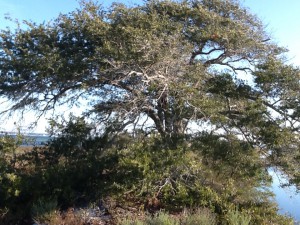
With the dunes blocking offshore winds trees can grow much larger on the back side of the island; like this live oak.
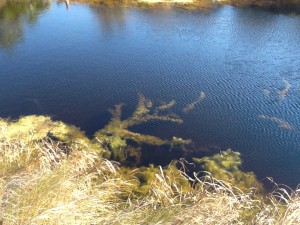
This pond supports a stand of green algae which supports many of the aquatic animals that visit here.
On this winter day I primarily saw bird life. The air temperature was 39 F and the wind was out of the north. Many of the mammals move at night and the reptiles, being cold blooded, were hibernating somewhere; the bird life however was pretty active. Many woodlands birds were out feeding on seeds and berries, herons and egrets were in the marsh hunting fish in the shallow waters, and shorebirds were picking through the beach wrack and some were diving.
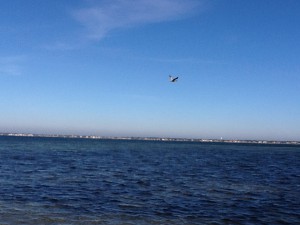
This pelican is searching over Santa Rosa Sound for a fish to feed on. Photo: Rick O’Connor
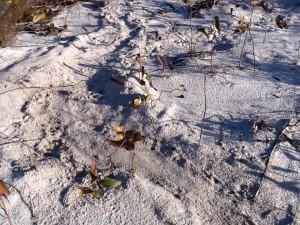
This unusual drag was found between the salt marsh and the sound side shoreline. It looks like a turtle crawl but at his time of year more probable something being dragged by something.
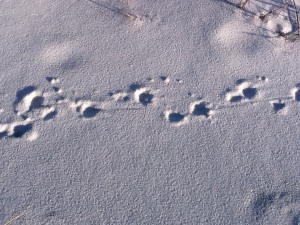
Armadillo tracks can be identified by their “tail drags”.
Salt marshes are one of the most productive systems on earth; and the target for another FLORIDA’S PANHANDLE series. Crabs, shrimp, mollusk, worms, terrapins, fish, and birds are some of the wildlife that call this place home – and maybe we will find some as this series continues into the warmer months. Today I found pelicans, herons, and egrets here eating.
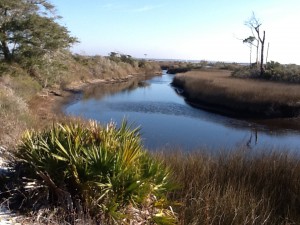
A finger of a salt marsh on Santa Rosa Island. The water here is saline, particularly during high tide. Photo: Rick O’Connor
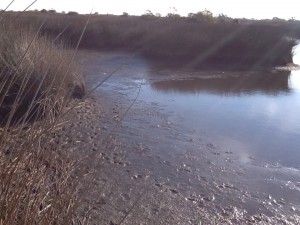
The muck of a salt marsh. This rich organic mud is very loose and the hiker can quickly sink! Notice the tracks of a predator.
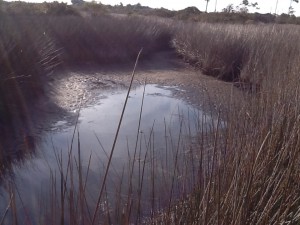
Notice the low water levels typical of winter. This congregates fish into smaller pools and makes it easier for birds and mammals to catch them.
The Sound side of the island has wind but less wind than the Gulf side. The wave energy here is also lower supporting seagrass and oyster communities. Like the marsh these places are very productive; though all I really saw moving on this cold winter morning were the birds. There are two species of seagrass common to our sounds; turtle grass and shoal grass. However there have been reports of more tropical species appearing. We may find some when the water warms up. These waters support at least 100 species of fish and many invertebrates we enjoy eating.
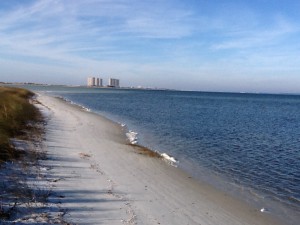
The darker areas in the water are seagrasses. Photo: Rick O’Connor
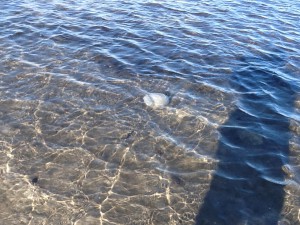
I found this along the shore last winter. These are cannonball jellyfish.
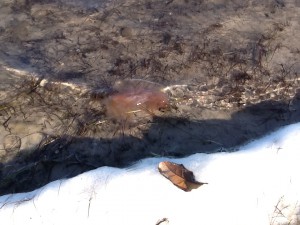
This is a sea nettle. This species of jellyfish has a more painful sting. I only saw one of these today but saw several cannonballs.
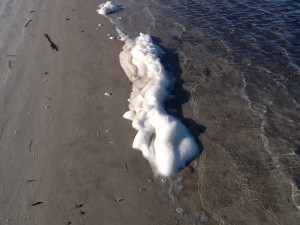
People find this “sea foam” frequently when they visit the beach. It is formed when the winds pick up and there are nutrients in the water. It was up and down the beach today.

It is not uncommon to find dead fish along the shore after a hard freeze as we have had in recent weeks. When it warms these dead fish will attract scavengers including cottonmouths. Maybe we will see one later in the year.
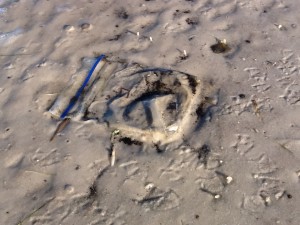
There was very little trash on the island today but it was there. These pieces of debris can cause serious problems for coastal wildlife. We will discuss this issue more as this series moves on.
Well, for January we found the beach to be cold and windy. Very little wildlife was out to be viewed other than birds and the numerous tracks in the dunes, but as the temperatures warm we will see more. Take some time to visit our barrier islands and enjoy them. Until February.












































